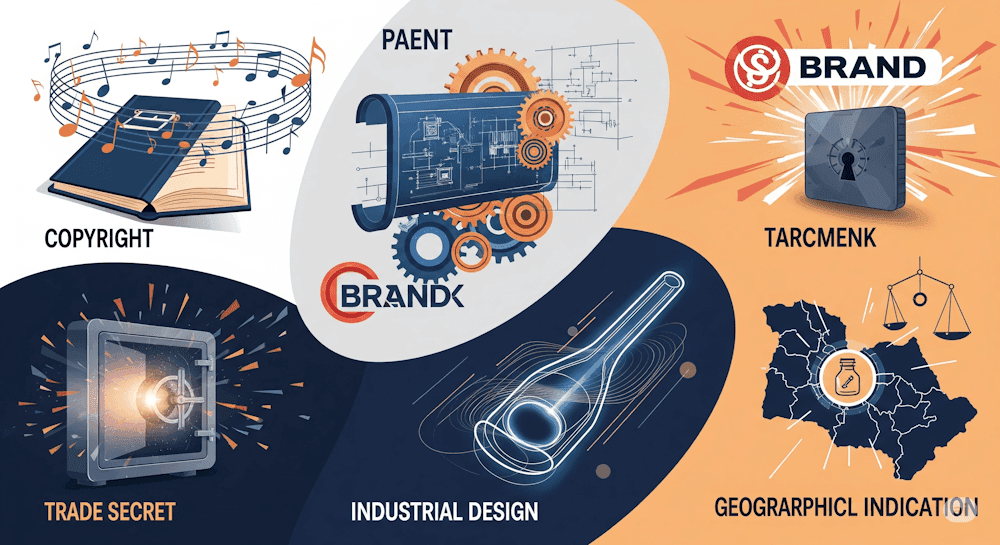So you know how in the last post we talked about what Intellectual Property even is? Cool. Now let’s talk about the types of it—because not all ideas are protected the same way.
Think of Intellectual Property like a toolbox. Depending on what you’ve made—an app, a brand name, a song, or a secret formula—you’ll need the right tool to keep it safe.
Some things get copyrighted. Some things get patented. Some are secret on purpose. Yeah, it’s a bit much at first, but let’s break it down.
1. Copyright – For Creative Stuff
If you’ve ever written a song, drawn something cool, made a short film, or even coded an app—you’re already in copyright territory.
Copyright protects:
- Books, poems, articles
- Paintings, sketches, photos
- Music, choreography
- Software (yup, code counts)
- Even stuff like architecture or ads
But here’s the catch: copyright doesn’t protect your idea—only how you express it. Like, you can’t copyright “a story about a wizard,” but you can protect the way you wrote Harry Potter.
More on this in our Copyright Guide
You get:
- Economic rights (like selling or licensing it)
- Moral rights (like keeping your name on it, and stopping people from ruining it)
And in India, copyright usually lasts 60 years. That’s more than enough time to blow up.
2. Patents – For New Inventions
Let’s say you invented something totally new. Maybe a device that makes cold coffee in 3 seconds. Or a medicine that cures hangovers (someone please do this, thanks). That’s where patents come in.
A patent protects:
- New machines
- Unique processes
- Innovative tech stuff
Basically, if it’s useful, new, and not obvious, it might be patentable.
You get 20 years to be the only one who can make or sell it. After that, it’s fair game. And during those 20 years, you can license it or sue people who copy it.
The only downside? Patents are expensive and take time to get. But if you’re working on a tech startup or product, it’s kinda worth it.
3. Trademarks – For Brands & Logos
This one’s probably the most visible type of IP. Trademarks are the signs, words, or logos that tell people: “Hey, this is us.”
Like the Nike swoosh. Or the McDonald's arches. Or the word “iPhone.” Those aren’t just designs—they’re legally protected trademarks.
You can trademark:
- Brand names
- Logos or symbols
- Taglines or even sounds (yep, the Netflix “ta-dum” sound is trademarked)
In India, you get 10 years of protection, and you can renew it forever. So yeah, if you build a strong brand, it’s worth protecting.
4. Trade Secrets – The Stuff You Don’t Want to Share
This one’s kind of sneaky, but in a legal way.
Trade secrets are things you don’t file paperwork for. You just keep them hidden.
Like:
- Coca-Cola’s secret recipe
- Your company’s marketing strategy
- A private list of suppliers
- That spreadsheet that shows how you price your product
The rule? If it’s valuable because it’s secret—and you’ve taken steps to keep it that way—it counts.
Downside? If someone figures it out on their own, it’s fair game. But if they steal it? You’ve got legal protection.
5. Industrial Designs – When Looks Matter
Ever notice how some products just look better? Like a sleek bottle, a futuristic phone shape, or a uniquely shaped lamp?
If the way your product looks is part of what makes it stand out, you might wanna protect that too.
That’s where industrial design rights come in. They cover the visual features—like shape, pattern, color, or texture.
Examples?
- Fancy packaging
- Chair designs
- Mobile phone shells
- Designer watches
If someone copies your design and uses it commercially? You can sue them, no problem.
6. Geographical Indications (GI) – For Local Legends
Ever seen stuff like “Darjeeling Tea” or “Banarasi Sarees” or “Champagne”? Those are protected under Geographical Indications.
Basically, a GI is used when a product owes its special qualities to the place it comes from.
It protects:
- Regional foods (like Mysore Pak or Kolhapuri Chappals)
- Local handicrafts
- Traditional spirits or textiles
So yeah, if you’re making something unique to your city or state, a GI tag helps preserve that identity and keep outsiders from cashing in on your legacy.
Learn more in our upcoming blog: Geographical Indications in India & Why They Matter
Okay, So How Do You Know Which One to Use?
Quick cheat sheet:
| You Made... | You Need... |
| A logo or brand name | Trademark |
| A painting, article, or song | Copyright |
| A new invention or device | Patent |
| A unique business formula | Trade Secret |
| A cool product design | Industrial Design |
| A local specialty product | GI tag |
And sometimes, you might need more than one. For example, your new gadget might have a patent, plus a trademarked name, plus copyrighted packaging. All three can overlap. That’s totally normal.
Final Thoughts (Real Talk)
Intellectual property might sound like legal mumbo-jumbo at first, but once you get it—it’s kinda empowering. It’s like giving creators their own legal superpowers.
You don’t need to be a lawyer to use it. Just understand what applies to your work, and protect your stuff before someone else profits off it.
Or circle back to: What Is Intellectual Property Anyway?



